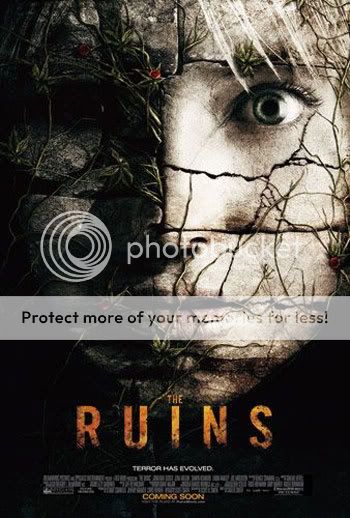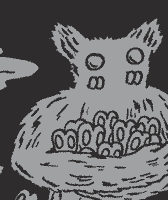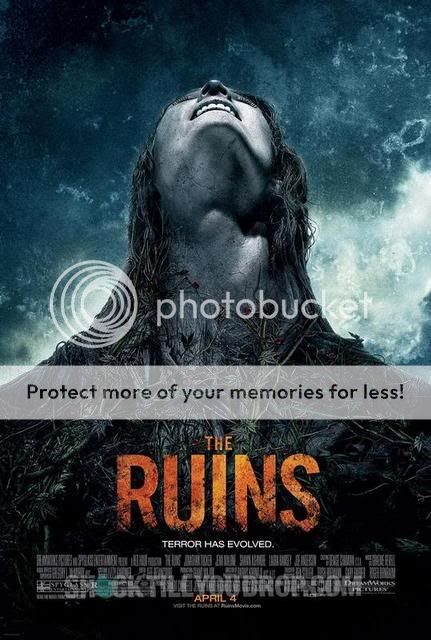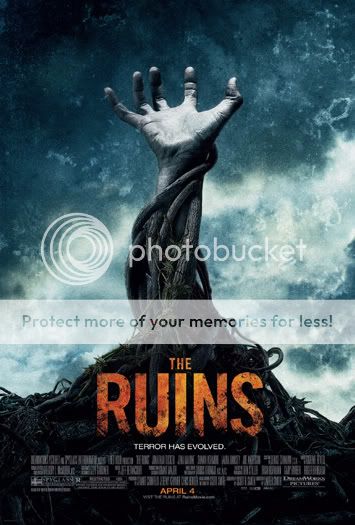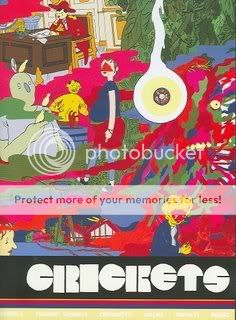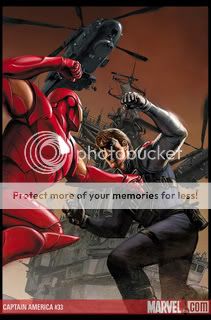Archive for February 29, 2008
Carnival of souls
February 29, 2008* Here’s the Iron Man trailer that ran during last night’s Lost episode. It’s pretty much as note-perfect for the character and concept as everything else we’ve seen from this movie so far. The likes of Mark Millar and J. Michael Straczynski and Joe Quesada should be thoroughly chastened by this. (Via Whitney Matheson.)
* Speaking of Millar, while I’m sure the dialogue in his Kick-Ass #1 is just as wooden and devoid of insight into actual human behavior and popular culture as Ian Brill says, I think Ian’s really overreaching when he keeps heaping scorn on the notion that high school kids don’t read superhero comics. Um, I did. It’s certainly a hip notion to suggest that they don’t, but not one that is borne out by reality if pretty much any trip I’ve ever taken to any comic store ever is any indication.
* Finally:
In the confession, Underwood said he lured the girl, his upstairs neighbor, into his apartment in Purcell, hit her with a cutting board, smothered her with his hands, sexually assaulted the body and nearly cut her head off as part of a fantasy involving cannibalism.
“I wanted to know what it tasted like, and just the thought of eating someone was appealing to me,” Underwood said in the confession.
[…]
Underwood told FBI he hit the girl her over the head with a wooden cutting board while she was watching television and playing with his pet rat.
Agents asked Underwood what the girl said after he hit her.
“That’s something that’s haunted me forever since it happened,” he said. “She started yelling, I’m sorry,’ which I’m like, What is she sorry for? She didn’t do anything wrong. It’s me. I’m the one that should be sorry.”‘
—“Jury takes minutes to convict cannibal killer,” AP, CNN.com
Comics Time: The Chunky Gnars: A Chocolate Gun Tribute
February 29, 2008The Chunky Gnars: A Chocolate Gun Tribute
Chris Cornwell, writer/artist
PictureBox Inc., October 2007
16 pages
$3.00
Like Paul Pope’s cover version of the first issue of Jack Kirby’s OMAC from his issue of Solo and Josh Simmons’s unauthorized Batman-as-psychopath minicomic Batman, Chris Cornwell’s Chunky Gnars mines the fertile vein of another creator’s work, in this case Frank Santoro & Ben Jones’s wondrous drug-teen-rock-action opus Cold Heat. I think these kinds of call-and-response comics can really tease out what works and doesn’t work in the original and be an extremely enlightening exercise for the responder.
In this case, Cornwell doesn’t quite hit the heights that the originators do, but to be fair that doesn’t seem like his intent–his goal is playing up the mixed-genre nature of Cold Heat for humorous effect, like having a rock-star-slash-assassin and an evil senator piloting a giant robot minotaur. Some of those moments are very funny, in fact, if a little catchphrasey–“I don’t start killin’…TILL I’M DONE ROCKIN’!!” shots the hipster assassin when the senator tries to get him to skip the encore and start the massacre. Better still is Cornwell’s funny-because-it’s-true depiction of the senator’s absurd, obliviously prurient fixation on the supposed evil of popular culture: Beads of sweat running down his bald head (which has suddenly been isolated against an oozing abstract background), he kicks off a test run of his latest speech with the immortal opener “We have become a nation that worships the rectum,” before his assistant unceremoniously cuts this reverie off.
While the whole thing doesn’t exactly cohere nor rise to the level of its inspiration, it does contain some gaze-worthy art that is at alternating times reminiscent of Santoro, Brian Chippendale, and in the second of its four title panels Beto Hernandez. Mostly it exists as a testament to how fired up Cold Heat has people, which is valuable in and of itself.
Carnival of souls
February 28, 2008* Water monsters on the march! Scientists have discovered the fossilized remains of a 50-foot prehistoric carnivorous aquatic reptile called a pliosaur, the biggest such creature ever found. (Via Matthew Yglesias.)
* Ain’t It Cool News reports that banes of Peter Jackson’s existence (and the existence of Lord of the Rings fans everywhere) Bob Shaye and Michael Lynne have jumped/been pushed from New Line, which is now a full sub-unit of Warner Bros.
* Here’s yet another striking poster for The Ruins. (Via Bloody Disgusting.)
* Here’s a nifty eight-minute recap video to bring everyone up to speed on Battlestar Galactica in time for Season Four. (Via Whitney Matheson.)
* Heidi MacDonald points out the irony inherent in a comic about the Holocaust, an atrocity perpetrated by people who believed other people were inferior to them by virtue of their Jewishness, by Dave Sim, a person who believes other people are inferior to him by virtue of their femaleness. Tom Spurgeon points out the foolishness of the position that one should separate evaluations of Sim’s work from evaluations of Sim’s ideas since the former is so thoroughly informed by the latter. And I point out that his work is ugly these days anyway.
* I liked this World War II poster that Andrew Sullivan dug up:
* Finally, no Lost links tonight, for some reason!
Carnival of souls
February 27, 2008* This is what heaven looks like:
A staircase made of bookshelves. I am a person who longs for shelf space like Gollum pined for his Precious, so this practically moved me to tears. (Via Topless Robot.)
* Details are emerging about The De2scent, the idiotically titled, Neil Marshall-less sequel to Neil Marshall’s truly terrific horror movie The Descent, most notably that it will star the main character from the first movie, which is…interesting, given the events of that film.
* This deeply, deeply unnerving video from Swedish dance act The Knife beats even Jack Palance doing one-armed push-ups in terms of being the best award-acceptance speech I’ve ever seen. (Via Pitchfork, who translate it from the Swedish.)
Comics Time: Aline and the Others
February 27, 2008Aline and the Others
Guy Delisle, writer/artist
Drawn & Quarterly, November 2006
72 pages
$9.95
On the one hand this book is an absolutely magnificent display of bravura cartooning–understated, energetic, loose as a goose, full of the joy of imagemaking. In a fashion reminiscent of Bill Plympton’s animated shorts, Delisle creates miniature portraits of various, mostly unpleasant women in wordless-strip form. The uniform layouts–tight grids of 15 tiny square panels per page–provides a static contrast by which we can marvel at Delisle’s effortless line and proficiency with delivering whatever tone he chooses–kinetic action in “Rita,” genuine erotic heat in “Diane” and “Karine,” delightful and unexpected visual puns throughout (my favorite, I think, was “Irene,” where both of the title character’s arms slide out of her left socket as though they were connected through her shoulders like an axle). Delisle chronicles his own sexual neuroses and issues with as much candor and visual cleverness as you’re likely to see this side of John Cuneo’s similar project nEuROTIC.
On the other hand, it’s quite easy to read this book as savagely misogynistic in its repeated reduction of women to their constituent body parts, or its repeated depiction of staid portly women as literally holding the pneumatic sluts within themselves prisoner, or its repeated message that women are materialistic, hypocritical assholes who’d just as soon make men miserable for no reason as look at them, let alone fuck them. Men don’t come off that great either, but that’s usually because they were stupid enough to get involved with women in the first place. The tone gets so strident that it flattens out the sophistication and creativity of Delisle’s ideas–cleavage and vaginas swallowing men whole, a literal vagina dentata, yes yes, we get it. It’s entirely possible that this is all quite self-aware–the existence of the androcentric companion volume Albert and the Others would appear to indicate that, though I haven’t read the book itself–but it’s also entirely possible that that doesn’t matter, and that at a certain point putting your conflicted or outright hostile feelings toward women on display leads to reinforcing them rather than confronting them. I honestly don’t know. It’s a powerful comic book, I’ll give it that.
Carnival of souls
February 26, 2008* Life imitates art: Two people were stabbed during a screening of the regular-people-run-amok horror film The Signal in Fullerton, California. (*) It doesn’t say so in the article, but the caption for the video report says it happened during a stabbing scene.
* Here is the only positive review of George A. Romero’s Diary of the Dead I’ve seen so far, by B-Sol at Vault of Horror.
* Dark Horse will be publishing hard-copy collections of Chris Onstad’s webcomic Achewood. I must confess that I learned a long time ago I don’t have the ability to follow a daily comic of any kind, but I’ve been holding out hope that maybe the complete strip would be published in book form one day, and I guess we’re one step closer to that. (Via Tom Spurgeon.)
* Speaking of Spurge, here’s a thought of the day from him that I’m still mulling over:
Does all horror stem from a betrayal of intimacy?
I would say that some of it does, but not all. Indeed I’d say that a lot of horror comes from forced intimacy, which I guess is in itself a form of betrayal.
* While this New York Post article on Lost bears the obvious scars of an editor who doesn’t know the show very well, it nevertheless has an interesting broad-strokes breakdown of what Seasons Four, Five, and Six are “about” from showrunners Carlton Cuse and Damon Lindelof. (Via The Tail Section.)
* Katherine Follet at Not Coming to a Theater Near You has posted an evocative review of Robert Frank’s legendary lost Rolling Stones tour documentary Cocksucker Blues. It’s a pan, not just of the movie but of the conduct of its subjects, all of which makes me want to see it more.
* Comparing Weekly Standard editor Bill Kristol to Daredevil villain Mr. Fear is about as close to comicsblogging as Jim Henley comes these days, but hey, I’ll take it.
(*) Perhaps they wanted to know where they could go to get their jeans embroidered.
Shameless self-promotion
February 25, 2008If you’d like to see my first published joke at the Onion’s video site, please click here and keep your eye on the scrolling text at the bottom of the screen for an item about a sixth grader.
Comics Time: Daredevil #103 & #104
February 25, 2008Daredevil #103 & #104
Ed Brubaker, writer
Michael Lark, Paul Azaceta, and Stefano Gaudiano, artists, #103
Lark, Azaceta, Tom Palmer, and Gaudiano, artists #104
Marvel Comics, December 2007 & January 2008
32 pages
$2.99
Daredevil is writer Ed Brubaker’s most overlooked book at the moment. It’s not as rollickingly entertaining as his and Matt Fraction’s wild genre mish-mash The Immortal Iron Fist, it’s not as character-defining as his Captain America, it lacks the “book I’ve always dreamed of writing” vibe of Criminal, and it’s not part of a high-profile crossover like Uncanny X-Men. What’s more, unlike Iron Fist or Cap, Daredevil is also up against years-long high-quality runs on the character, by the likes of Frank Miller and Brubaker’s immediate predecessor on the title, Brian Michael Bendis. And one thing that came up repeatedly during my monthly discussions of the series while at Wizard is that it’s one of the least showy superhero titles around: with no stunts, no events, no reboots, it’s simply consistently good issue after issue, which bizarrely works to its detriment in terms of maintaining a high profile with critics and readers. That’s a shame, because man, this is a very satisfying masked-vigilante comic.
Forget Spider-Man/Peter Parker: Matt Murdock is Marvel’s true everyman hero. Not in the sense that he’s a dork who lives in his aunt’s basement, but in the sense that he’s someone who, but for his blindness and super-senses and ninja training and red pajamas, you feel like you could actually meet in New York City: a rich lapsed Catholic pussyhound lawyer who can’t stand losing. That regular-guy vibe is used quite well in Brubaker’s run: The character is constantly shown bouncing between his superheroic activities and his civilian ones, on an almost scene by scene basis, like superheroing is a job he just can’t leave at the office and affects his life accordingly.
More importantly, those superheroic activities consist almost solely of beating criminals until they do what he wants. (Another Wizard colleague once told me that you can always recognize a bad Batman story by whether or not he’s acting like Daredevil, i.e. solving cases with his fists instead of his brain.) Now, it shouldn’t be hard for anyone who’s lived through the past few years to make the connection that what our superheroes do all the time, our government has to ignore international human rights treaties to get away with. In keeping with that Marvel-realist tone, Brubaker tackles the torture aspect of Daredevil’s vigilante activities head-on in this storyline (a blowtorch factors in at one point), and the result leaves us feeling refreshingly uncomfortable with our ostensible hero. He also portrays supervillain-driven gang wars in a convincingly ground-level way, simply replacing the strategic use of an AK-47 or a well-orchestrated hit (or, if you prefer, appearances by Luca Brasi or Omar Little) with the arrival of the Wrecking Crew or the Enforcers.
He gets slightly less mileage out of Murdock’s tortured-as-always romance, this time with his villain-targeted wife Milla–forgivable, considered how well-worn that territory is for the character. I think perhaps he could have tried to ground her slide into dementia by couching it in the emotional language of losing a loved one to depression, alcoholism, Alzheimer’s, or some other more relatable mental disease; perhaps he’ll get there eventually. For now, as aided and abetted by the fits-this-writing-to-a-tee art of the team led by Michael Lark, he’s cranking out a heck of a superhero book anyway.
This house is clean?
February 24, 2008Last night the Missus and I spent a lovely evening courtesy of Turner Classic Movies, watching Psycho, The Birds, and Poltergeist in a row. As a marathon, it was not flattering to its concluding film. Granted, Hitch is a tough act to follow, especially with those movies–she and I were astonished anew at Anthony Perkins’s heartbreakingly naturalistic performance, the still-shocking violence of the shower scene, Martin Balsam’s oh-crap-I’m-in-the-wrong-movie private dick, the sheer relentlessness of bird attacks on children, the proto-Night of the Living Dead house under siege, and on and on and on. By comparison, Poltergeist is pretty freaking stupid.
I’m honestly kind of baffled as to why that movie has the scary reputation it does. Maybe it’s “the curse” and the tragic fates of Dominique Dunne and Heather O’Rourke? I guess it’s the nature of the film’s scariest images–simply put, they’re tailor-made to scare the living shit out of any little kid who saw the movie while still in grade school. Evil clowns, evil toys, evil backyard trees, getting sucked into the closet, eerie TVs left on in the dark, parents who can’t save you…that’s all straight outta Spielberg’s eight-year-old id, from what I understand. But for grown-ups, it’s really rather weak.
And it’s not just the goofy and boring nature of the fright images the filmmakers deploy–it’s how haphazardly they deploy them, with seemingly no regard to a crescendo of escalating horror. Once you’ve seen lasers shoot out of the wall, who cares that the chairs are rearranging themselves? How do you expect the audience to process a sudden leap from slip-sliding across the kitchen floor like a cool carnival ride to a man-eating tree and a haunting with the power to trap a kid in another dimension–in the space of a few hours?
By the time the paranormal investigators show up, Craig T. Nelson and JoBeth Williams are treating the disappearance of their daughter following their son’s near-murder by an evil Ent and an ongoing paranormal riot in the kids’ bedroom like a particularly unpleasant bedbug infestation. So long, high stakes. No one’s reaction to what’s going on seems commensurate with the magnitude of the supernatural occurrences they’re witnessing, even though the script goes out of its way to downplay the investigators’ most notable prior experiences. And again, it bounces super-rapidly between novelty-act stuff like old jewelry dropping from the ceiling and a Hulk action figure flying around, to grand-guignol horror like a maggot-infested chicken wing and a guy tearing his own face off, back to Spielbergian “wow!” moments like a ghost parade down the staircase. I don’t know if this is a product of the uneasy collaborative dynamic between nominal director Tobe “Texas Chain Saw Massacre” Hooper and screenwriter/producer/de facto director Steven Spielberg or what, but it plays havoc with the film’s pacing and leeches the pizzazz out of the scares. And once Zelda Rubenstein shows up and they go through that absurd physical business with the tennis balls and the rope and the bathwater, I was yawning and ready to change the channel. (For a far more effective combination of the supernatural with physically-verifiable science-fiction trappings, see Ghostbusters.) Also, if you can figure out why they go through all that trouble to establish that she’s the real deal only to have her erroneously pronounce the house free of hauntings anymore, please fill me in.
But you know what is compelling about the movie? All that gloriously weird suburbia subtext! I’m not even sure the filmmakers realized what a bizarre beneath-the-surface look at three-kids-and-a-dog middle-classness they were providing. You obviously don’t have to be a rocket scientist to figure out what they were getting at with building developments on top of graveyards–in terms of metaphorical subtlety it’s up their with Dawn of the Dead‘s zombies in a shopping mall–or by opening with the Star Spangled Banner. But what about the fact that JoBeth Williams’s extravangly MILFtastic mother is 32 and her oldest daughter is 16? What about the pot-smoking scene, or the alcoholic desperation of Craig T. Nelson’s football-watching buddy’s beer run? What about the oldest daughter showing up at the very end with two huge, unexplained hickeys? What about Mom getting a kick out of the construction workers hitting on her daughter? What about Williams spending much of the climactic sequence with her panties on display? What about the seemingly endless amount of conspicuously consumed stuff in the kids’ bedroom? What about that vagina tunnel into the afterworld? I don’t think it’s at all surprising that the sequence that’s the most effectively scary, the climax, is the one where this stuff all comes to the fore most directly. I almost feel like when people remember Poltergeist, they’re transferring their impressions of that strange, and therefore frightening, final sequence onto the rest of the movie.
Whoops!
February 23, 2008I’ve just been informed that all the WizardUniverse.com pieces of mine linked over in the sidebar–interviews with Damon Lindelof, Eric Reynolds, Johnny Ryan, Jordan Crane, and so on–have disappeared, along with, it seems, everything up on the site prior to the redesign they did a few weeks ago. I’ll try to dig them up and repost them here, I guess.
Carnival of souls
February 23, 2008* There’s a third poster for The Ruins out there, an alternate take on one of the two earlier posters–which prompts this utterly baffling statement from Bloody Disgusting:
What makes this one sheet different (and better) than the one posted earlier is that the woman on the poster has her mouth open.
Um, okay.
* According to Variety, the U.K. theater chain Odeon is refusing to show Rambo for undisclosed “commercial reasons.” The Variety article does not seem to suggest that this has anything to do with Rambo‘s totally awesome violence.
* Zachary Wigon at The House Next Door bemoans what he feels is a lack of critical focus on content (as opposed to formal technique) in No Country for Old Men. In my experience, beyond a half-hearted sentence about how pretty it is or, perhaps, the dopey argument that its technical proficiency makes it a bad movie, just the opposite has been true, and everyone sits around trying to figure out what it all meeeeeeeans based on who was in what hotel room or whether Chigurh was carrying a weapon in such and such scene or whether the words “dog collar” are an Abu Ghraib reference and on and on. I’ve found the vast majority of writing on this film useless in its tendency toward “decoding” the story, which I think is why I haven’t done any myself despite the fact that it was my favorite movie of the year. Sometimes a Chigurh is just a Chigurh.
* And sometimes Chigurh goes to Arby’s.
* Finally, this week’s Horror Roundtable is about the best and worst characters in horror. We have such sights to show you…
Comics Time: Teratoid Heights
February 22, 2008Teratoid Heights
Highwater Books, Summer 2003
Mat Brinkman, writer/artist
176 pages
$12.95
Buy it from Bodega Distribution
Originally written on March 8, 2004 for publication by The Comics Journal; a longer alternate version appeared on this blog
Cartoonist Mat Brinkman is the most compelling member of the Fort Thunder art collective, combining the whimsy and chops of a Brian Ralph with the weirdness and choppiness of a Brian Chippendale or a Jim Drain. And in this little book, he’s created a minor sequential-art masterpiece. This nearly wordless, black-and-white collection of short adventure stories, in which a variety of monstrous, faceless creatures explore their respective environments with alternately hilarious and frightening results, recalls Jim Woodring’s Frank stories, in its deft use of scary-funny black humor and unexpected surprises. But it eschews Woodring’s familiar funny-animal tropes for something new, eerie, and original. The art, which simultaneously possesses the starkness of woodcuts and the manic detail of the ’60s undergrounds, quite simply looks like a transmission from Another Place.
Each of Teratoid‘s subsections has its strengths: The wild wanderings of “Oaf” are notable for their emotional range and their visceral description of this fantasy world’s geography; The simply-drawn creatures of “The Micro-Minis” are like cartoon automatons, their actions flowing naturally from their own design as a function of the very mechanics of drawing them; The wordplay of “Cridges,” the book’s only non-silent section, show Brinkman to be as able and witty a manipulator of language for its own sake as he is of art. The book’s real tour-de-force, though, comes in the section called “Flapstack,” which concerns the subterranean realm of little creatures that look a lot like pulled teeth. That section’s story “Sunk” is, I think, the single best comics sequence I read all year. Three of the teeth creatures, each bound to the other by a length of rope, fall into a winding labyrinth. As they try to navigate this complex maze, Brinkman intercuts between them as though multiple cameras are involved. The three creatures are indistinguishable but for the corresponding numeral that appears each time they come back “on screen.” Before long we have a sense of exactly where in the maze each creature is, and it’s the intense concentration required to keep up with Brinkman’s byzantine constructions that attaches us to the creatures as surely as their frustratingly short lengths of rope attach them to each other. As they attempt to overcome the obstacles they encounter, the tension is, almost stunningly, an edge-of-your-seat affair. The powerful end to this thriller–which, again, stars three silent and indistinguishable walking teeth–is testament to the power of the medium when artists deploy it in new and sophisticated ways, and to Brinkman for having the vision to do.
Carnival of souls
February 21, 2008* Lost link number one: An enlightening Jeff Jensen interview with show honchos Damon Lindelof and Carlton Cuse at Entertainment Weekly that clarifies some unintentionally ambiguous points from last week’s episode regarding the chronological order of flashbacks, a certain notable bracelet, and lots more. Quote of the day:
The only true canon is the show itself.
Then explain the goddamn numbers in the goddamn show instead of the stupid ARG! Okay, venting over.
* Lost link number two: The Tail Section clears up some erroneous reporting regarding Lost‘s scheduling–they are airing the eight pre-strike episodes all in a row, and the second batch will all be airing at 10pm.
* The Ruins link number one: new trailer!
* The Ruins link number two: New posters!
Trailer and one-sheets via Bloody Disgusting.
* Comics Bulletin’s Robert Murray talks to writer Simon Oliver and editor Jonathan Vankin of the canceled-before-its-time Vertigo series The Exterminators. To me this series, rough edges and all, is the most interesting thing going on at Vertigo today, and the fact that it has to call it a day 20 issues earlier than its planned 50-issue run is a real downer. I guess they can’t all be Y: The Last Man or Lost. However, it does at least give you a better financial impetus to invest in the trade paperbacks. (Via Kevin Melrose.)
* The mostly not-so-good Gawker Media “sci-fi” blog io9 has a coup of an interview with Cloverfield monster designer Neville Page. The three-decades-old legacy of H.R. Giger’s Alien design lingers on. (Via Whitney Matheson.
* Stacie Ponder calls out the genre-nerd internet for its weirdly negative sight-unseen reaction to Neil Marshall’s retro-apocalyptic thriller Doomsday. To me this kneejerk reaction is just part and parcel of other dopey horror-fanboy shibboleths: gore is good, PG-13 and M. Night Shyamalan and any trend that doesn’t involve constant on-screen dismemberment are bad, we must support Our Genre, etc.
* The new Meathaus anthology, featuring Jim Rugg, Ross Campbell, Dave Kiersh, Brandom Graham, Farel Dalrymple, James Jean, the Hanuka Bros., Dash Shaw, and Ralph Bakshi (!), looks pretty pretty. I will however admit some reticence, because in the post-Kramers Ergot and Mome world, the content bar has really been raised–there’s more to anthologies than pretty drawings. (Via Heidi MacDonald.)
Wow.
February 20, 2008David “Fight Club” Fincher is directing the film adaptation of Charles Burns’s Black Hole, the best horror comic of all time. And the project has migrated from MTV Films to its parent company, Paramount itself. (Via Kevin Melrose.)
Comics Time: The Would-Be Bridegrooms
February 20, 2008The Would-Be Bridegrooms
Shawn Cheng, writer/artist
Partyka, 2007
36 pages
$4
The most recent minicomic by my friend Shawn Cheng sees him continuing to mine his interest (obsession?) with bestial forms, particularly the almost manic detail found in art representing the mythical monsters of Native and South American cultures. As opposed to the bleakness of his Ignatz-nominated collaboration with Sara Edward-Corbett The Monkey and the Crab, this one is much more playful in nature, despite sharing with that earlier work a plot involving a game of one-upsmanship gone horribly awry. As his coyote and jackrabbit protagonists play their game of dueling transformations to impress the grandma of their prospective bride, the fun is in watching Cheng’s character designs evolve from knowingly lo-fi (dig the coyote’s first-grader triangle for a nose) to hilariously baroque. Quickly running out of ideas, the two would-be bridegrooms start repeating themselves, producing high-level video-game variants on earlier creatures they’ve transformed into (“DEMONIC Ice Giant!” “MUTANT White Bear!”); once they max out their imaginations with their absurdly complex World Serpent and Thunderbird creations, they pause, give up and simply start beating each other up. All this is smartly offset by the constant observing presence of the adorable little round-headed grandma. (Her startled squeal of “Oh!” upon seeing the first transformation tickled me pink.) It’s she who gets to deliver the story’s punchline/moral, which is that showoffs inevitably lessen themselves compared to the woman they intend to impress. It’s an appropriate ending for a neato little mini that uses an understated, perhaps even slight, narrative to, yes, impress.
Carnival of souls
February 19, 2008* NBC is abandoning the traditional September-May TV season next year in favor of the 52-week rollout that’s been the de facto model for the past few years anyway. In terms of the few shows I care about I think this is good, as arbitrary scheduling decisions should have less of an impact on storytelling decisions, although I guess none of it really matters until Nielsen rejiggers sweeps.
* Stacie “Final Girl” Ponder rather hilariously interviews American Psycho screenwriter Guinevere Turner. Definitely check out the photo captions.
* B-Sol at the Vault of Horror rightfully praises Robert Carlyle’s jaw-droppingly powerful performance in 28 Weeks Later as Oscar-worthy in an alternate universe where such performances get noticed by anyone who doesn’t also happen to have a zombie escape plan committed to memory.
* Man, someone give this guy a self-published comic about women and fashion! (Via Heidi MacDonald.)
* Ken Lowery tries to explain why he doesn’t like “torture porn,” but in lumping together and subsequently dismissing a whole slew of movies including the Saw series, the two Hostel movies, Turistas, The Devil’s Rejects, Chaos, and so on, he disregards separating the wheat from the chaff in any meaningful way, and moreover discusses only one of those films in any kind of detail, so even if his argument is that there is no wheat, that’s not at all clear. I think one day we’ll be as unlikely to hear these kinds of arguments from genre buffs as we currently are to hear them say “slasher movies are no good” as though there’s no difference between Halloween and Jason Takes Manhattan.
* Finally, nightmare fuel: A deep-sea video camera captures images of dozens of giant sea spiders.
¡Jesus Marimba!
February 19, 2008As if I didn’t like the cerebral English dance act Hot Chip already, the video for their new single is laden with references to Tim Burton’s Batman, the superhero movie that makes all subsequent superhero movies look like the humorless, gutless, visually inert experiments in tedium they are. I count Axis Chemicals, the little giftwrapped box that the Joker sends Vicki Vale a gasmask in, throwing paint at the statues, “you’re my number one guy,” Prince’s half-Joker “Gemini” character and Vicki Vale’s black dress from the “Batdance” video…I am in LOVE.
Carnival of souls
February 18, 2008* Appy polly lodgies for the blog outage for the last few days. Fortunately my MT software soldiered on in secrecy, which is why you can now find reviews of Ed Brubaker & Steve Epting’s Captain America and Eleanor Davis’s The Beast Mother below.
* The government of China, which hey by the way is responsible for approximately 2/3 of the world’s state executions, has banned all horror, alien, occult, and supernatural-related media.
* When comics critics collide: Tom Spurgeon interviews Doug Wolk. It’s full of great stuff, including investigations of Wolk’s reactions to various creators and comics, the value of “conversation-starting” and shared universes, and tons more. If you’re interested in comics criticism you should certainly read the whole thing.
* A small part of the interview touches on something I said, which I think bears clarification. In referring to my disapproval of his own excitement about Dave Sim’s upcoming project Glamourpuss, Doug says…
If I had to limit myself to art by people whose world-views matched mine, I wouldn’t have a lot left, and if I couldn’t enjoy art by people whose world-views I find repugnant, I’d lose some things that mean a lot to me.
I’ve said the exact same thing from time to time and still believe it; however, to the extent that an artists repugnant world-views are the subject of their art, as is the case with any Dave Sim comic purporting to be about women, I think it’s perfectly legitimate to find the art just as repugnant as the worldview, no matter how pretty or inventively laid out it might be. (And let’s just say I beg to differ on that score as well. I mean, Jesus.)
* This week’s Horror Roundtable asks us to name a scene in a horror movie that brought us close to tears. After watching the episode of Twin Peaks last night, I’ve got another one to add to the list.
* Another day, another pan of Diary of the Dead, this one from Ken Lowery. Meanwhile it didn’t make a whole lot of money during its opening weekend even on limited-release terms. I’m less excited about schlepping into the city to see this thing with each passing moment.
* The upcoming Hellraiser remake is now going to be written by the screenwriters of Saw IV. Joy. Hey, maybe it’s a wonderful film.
* Am I the only person who thinks that Cloverfield monster toy is inaccurate? I seem to remember its forepaws (or whatever you’d call them) facing backwards, with the wrist or ankle joint pointing the feet back, not forward. I remember that being a very disconcerting detail in fact. (Via Topless Robot.)
* Thanks to the opening of Victoria Large’s review of The Signal, I’m now officially intrigued by the movie, even though I sort of think it would be nice if reviews of horror films could save the pop sociology until at least the second graf.
* Check out this far-out cover to Sammy Harkham’s Crickets #2! Via K. Parille.
* Finally, via Whitney Matheson, an excerpt from the novelization of Road House.
Comics Time: The Beast Mother
February 18, 2008The Beast Mother
Eleanor Davis, writer/artist
Little House Comics, 2006
19 pages
$5.00
Vainly hope to buy it from Little House
Like The Wicker Man (the original, not the nightmarish Nic Cage version, and God am I tired of having to say that), this beautiful minicomic by the prodigiously talented artist Eleanor Davis smartly plays upon and then reverses the ingrained sympathies of the modern genre reader. What appears to be a simple, perhaps even simplistic fable about a maternal monster, a man with a gun, and how we kill what we don’t understand turns out, in a fairly grim (perhaps even Grimm) fashion, to carry almost precisely the opposite message, albeit with enough ambiguity to keep you uncomfortable long after you’ve finished.
Davis is a thrillingly precise artist. In a slightly different world her art might have drifted into the overly slick style of the Flight school of animation refugees; instead it stops short of their cold cartoonishness thanks to unexpected touches of vulnerability in the character design and figure work (she’s Young Comics’ preeminent poet of breasts and body hair), yet without sacrificing a sense that every line is going exactly where she wants it to. Her use of black is powerful, guiding the eye around her immaculately composed layouts and as strongly delineated as the mini’s ridiculously attractive die-cut cover. Best of all she ends the thing with no fuss or fanfare–nasty, brutish, short, and highly recommended.
Comics Time: Captain America #33 & #34
February 15, 2008Captain America #33 & #34
Ed Brubaker, writer
Steve Epting, artist
Marvel Comics, December 2007 & January 2008
24 pages, $2.99 each
What can you say about a series that in one issue sees a disembodied cybernetic arm spring to life and effect a prison break like the Addams Family’s Thing on steroids, and in the next sees protests over mortgage foreclosures and high gas prices lead to a brainwashed squad of S.H.I.E.L.D. agents opening fire on unarmed civilians outside the White House? Taken together these two scenes illustrate the best thing about Ed Brubaker’s run on Captain America, which itself may well be the best thing ever to be done with the character: It blends all the disparate Captain America flavors—two-fisted World War II hero, star-spangled costumed superhero, Steranko superspy, gritty black-ops badass, American icon, Marvel Universe elder statesman, post-9/11 symbol of Where We Are As A Nation—into a smoothie of pure action-adventure satisfaction.
Of course, since his “death” (sorry, can’t help but put it in quotes) in the series a few months back, Cap himself is nowhere to be found in the book that bears his name, and everyone and their grandmother will tell you it’s a testament to the handle Brubaker has on the cast of supporting quasi-super characters–Sharon Carter/Agent 13, Bucky/The Winter Soldier, the Falcon, Black Widow, Iron Man, Nick Fury, Union Jack, Spitfire, the Red Skull, Doctor Faustus, Arnim Zola–that the book remains eminently readable. Everyone and their grandmother is actually wrong, but only because the way they’re framing the issue is so silly: I understand the expectations inherent in the concept of “title character,” but Brubaker is a skilled craftsman and so are his main artists on this title, Steve Epting and Mike Perkins, so the notion that the death of Steve Rogers–in terms of superhero secret-identity complexity, we’re not talking Peter Parker or Bruce Wayne here–would scotch the whole affair reminds me of that Seinfeld routine where he says that people who get passionate about their local sports teams are essentially rooting for laundry. No, what’s impressive about the continued quality of this series is Brubaker’s grip on the tone–how the absence of Cap has seemed only to intensify Brubaker’s abilities to draw from the strengths of all the aforementioned aspects of the character by extending them to his entire milieu. This sleight of hand is so deft that you’re so caught up with the cloak-and-dagger stuff involving various superpowered people infiltrating AIM and RAID and Kronas and so on that when the entirely organic-feeling results of those organizations’ schemes–the destabilization of the American economy via problems we in the real world are currently facing in slightly less intense forms–come to light, you’re just staggered by how appropriate it feels, even in a book where a major supporting character has the mutant ability to talk to birds. Heck, the guy even gets something interesting out of Mark Millar’s astonishingly stupid Civil War plot by playing the victorious Iron Man as a conqueror with a conscience.
The big hook in issue #34 is that Cap’s old sidekick and current ex-Manchurian Candidate, Bucky, has now assumed the Captain America mantle. I don’t really understand why his new suit is shiny, other than it gives designer Alex Ross an excuse to bathe his paintings of it in even more sourceless white glow than usual, but who cares? He makes an interesting candidate for the position because unlike Rogers, who could only grieve over the horrors of the world, Bucky, like America itself, has actually committed a few. Now he’s trying to make up for it, and hey, we can relate, I think.
The festivities in these issues are underpinned by Epting’s muscular, much-imitated noirish stylings. His action choreography is impeccably intelligible, his punches feel like physical things, and he clearly has a great time with the costumes, uniforms, and tech that give the book its superheroic sheen even as he dirties it up with unidealized faces and blacks galore. His Red Skull is intimidating as heck, too; thanks to the plotline, it’s once again a mask rather than a guy with a skull for a face, and those normal eyes peeking out from behind all that latex or whatever it is are reminiscent of those shots in Texas Chain Saw where you can see Leatherface’s peepers rolling around beneath the mask. He’s creepy, in other words, and makes a great enemy for one of the three or four best superhero titles on the market today.



